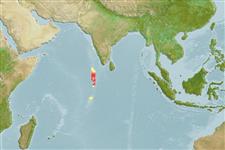Environment: milieu / Zona climática / intervalo de profundidade / distribution range
Ecologia
marinhas demersal; intervalo de profundidade 0 - 10 m (Ref. 12235). Tropical
Western Indian Ocean: presently endemic to the Maldives.
Tamanho / Peso / Idade
Maturidade: Lm ? range ? - ? cm
Max length : 2.8 cm SL macho/indeterminado; (Ref. 12235)
Descrição suscinta
Chaves de identificação | Morfologia | Morfometria
Espinhos dorsais (total) : 15 - 17; Raios dorsais (total) : 9 - 11; Espinhos anais: 1; Raios anais : 17 - 21; Vértebras: 35 - 36. Diagnosis: Dorsal fin III + XIII+ 10, 2nd fin twice height of 1st; anal fin I + 16-18; pectoral rays 15 (3+6+6); pelvic fin I, 2, spine short and hidden, segmented rays simple, partially united by membrane. Vertebrae 10 + 25-26. LL total lateral scales 36-38; tubed 13-21 (16-17) scales, ends below 3rd dorsal fin; nape, belly, 1st dorsal fin and anterior anal-fin base scaleless, caudal-fin base with 2 rows of scales. Mandibular pores 3+2-1+3. Labial folds and orbital cirrus absent. Head length 3.4 in SL; eye 2.4, maxilla 2.3 in HL. Males overall reddish with bluish dots and streaks on head, forming stripes anteriorly on body, ventrally light grey, fins pigmented; females paler, without spots and stripes, ventrally white, fins transluscent (Ref. 75031).
Body shape (shape guide): elongated.
Eggs are hemispherical and covered with numerous sticky threads that anchor them in the algae on the nesting sites (Ref. 240). Larvae are planktonic which occur primarily in shallow, nearshore waters (Ref. 94114).
Ciclo de vida ou comportamento de acasalamento
Maturidade | Reprodução | Desova | Ovos | Fecundidade | Larvas
Fricke, R. and J.E. Randall, 1992. Tripterygiid fishes of the Maldives Islands, with descriptions of two new species (Teleostei: Blennioidei). Stuttg. Beitr. Naturkd. A Biol. (484):1-13. (Ref. 12235)
Status na Lista Vermelha da UICN (Ref. 130435: Version 2025-1)
Ameaça para os humanos
Harmless
Uso pelos humanos
Ferramentas
Relatórios especiais
Baixar XML
Fontes da internet
Estimates based on models
Preferred temperature (Ref.
123201): 28.4 - 29, mean 28.9 °C (based on 53 cells).
Índice de diversidade filogenética (Ref.
82804): PD
50 = 0.5000 [Uniqueness, from 0.5 = low to 2.0 = high].
Bayesian length-weight: a=0.00617 (0.00288 - 0.01322), b=3.04 (2.86 - 3.22), in cm total length, based on LWR estimates for this (Sub)family-body shape (Ref.
93245).
Nível Trófico (Ref.
69278): 3.0 ±0.3 se; based on size and trophs of closest relatives
Resiliência (Ref.
120179): Elevada, tempo mínimo de duplicação da população menor que 15 meses (Preliminary K or Fecundity.).
Fishing Vulnerability (Ref.
59153): Low vulnerability (10 of 100).
🛈
Nutrients (Ref.
124155): Calcium = 2040 [661, 12,721] mg/100g; Iron = 6.83 [2.05, 20.12] mg/100g; Protein = 17.2 [15.2, 19.2] %; Omega3 = 0.149 [0.026, 0.935] g/100g; Selenium = 114 [15, 698] μg/100g; VitaminA = 12.2 [1.2, 122.0] μg/100g; Zinc = 7.22 [2.73, 15.71] mg/100g (wet weight);
